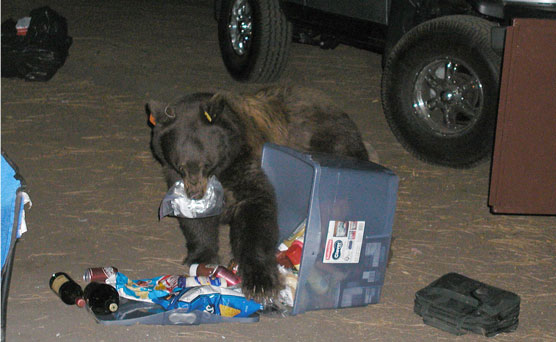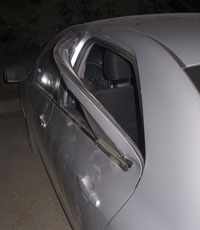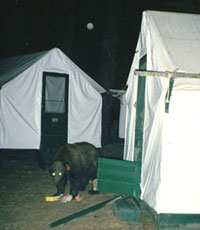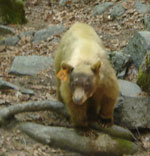 |
 | |
  | |
|
|
|
|
Yosemite National Park
Bears and Food Storage
|
|
|
|
|
|
 |

|
| Photo by Jeffrey Brooker |
This bear is in a campsite eating food from an open locker.
Exciting? Scary? Tragic? All of these describe the situation. Bears that frequently get human food often lose their fear of people and then end up being killed to protect people. Keep reading to learn how you can help protect Yosemite bears. |
|
|
Yosemite National Park is home to hundreds of American black bears; these bears have a voracious appetite. They also are incredibly curious and have an amazing sense of smell. This combination tempts them to seek our high-calorie food. Sometimes bears that routinely get our food become aggressive, and sometimes have to be killed as a result. By storing your food properly, you can prevent a bear's unnecessary death.
Please note that these food storage regulations have the force and effect of federal law: Failure to store your food properly may result in impoundment of your food or car and/or a fine of up to $5,000 and/or revocation of your camping permit.
|
 |
| Bears will break into cars to investigate any object that smells or looks like food. |
 |
What is Food?
"Food" includes any item with a scent, regardless of packaging. This may include items that you do not consider food, such as canned goods, bottles, drinks, soaps, cosmetics, toiletries, trash, ice chests (even when empty), and unwashed items used for preparing or eating meals. All these items must be stored properly.
How to Store Your Food...
In your car
You may store food inside your car (with windows completely closed) only during daylight hours. Do not store food in your car after dark: use a food locker. Remember to clear your car of food wrappers, crumbs in baby seats, and baby wipes. Even canned food and drinks must be removed from your car.
Food lockers are available at Curry Village parking lots and at nearly all trailhead parking areas.
|
 |
| Bears can easily break into tent-cabins and tents for food. Never keep food, drinks, toiletries, or trash in your tent or tent-cabin. |
 |
In campgrounds, Housekeeping Camp, and Curry Village tent cabins
You must store all your food in food lockers. Bears may enter campsites even in your presence (see photo above), and some will even check lockers to see if they’re latched.
- Keep your locker closed and latched at all times, just like you would a freezer.
- Only have the food out that you are actually using; if you're not using it, put it back into the food locker.
- Finally, treat your trash like food: keep it in your food locker or dispose of it in a bear-proof dumpster; do not leave it sitting out.
Food lockers are available at every campsite, Housekeeping unit, and Curry Village tent cabin.
Food may be stored out of sight in hard-sided trailers and RVs, as long as windows, doors, and vents are closed when you're not there. Food may not be stored in pop-up or tent trailers, or other soft-sided campers.
In your hotel room or cabin
You must keep all food inside your room; if you are not in the room, the windows and doors must be closed. Bears can easily break into cabins through an open door or open window.
|
 |
| Photo by Sean Crom | | A bear approaches people hiking down the Mist Trail. If a bear approaches you, try to scare it away. |
 |
In picnic areas and on the trail
Always keep your food within arm's reach and don't turn your back to your food; never leave food unattended. Bears may investigate picnic areas or backpacks for food even in your presence, so be alert.
While backpacking in the Wilderness
Bear resistant food containers ("bear canisters") are required for overnight hikers throughtout the Wilderness (counterbalance food hangs are no longer legal). In Yosemite and the southern Sierra, bear canisters are the only effective and proven method of preventing bears from getting human food. Read more...
|
|

|
 |
|
|
|
|
|
 |
|
Did You Know?
Natural fires in Yosemite are often no more than a single burning snag (standing dead tree) or a slow moving, low intensity fire that cleans underbrush from the forest floor. These fires prevent unwanted fires by removing accumulating forest debris that can fuel a larger fire in hot, dry conditions.
|
|
|
|
Last Updated: March 31, 2008 at 17:28 EST |






